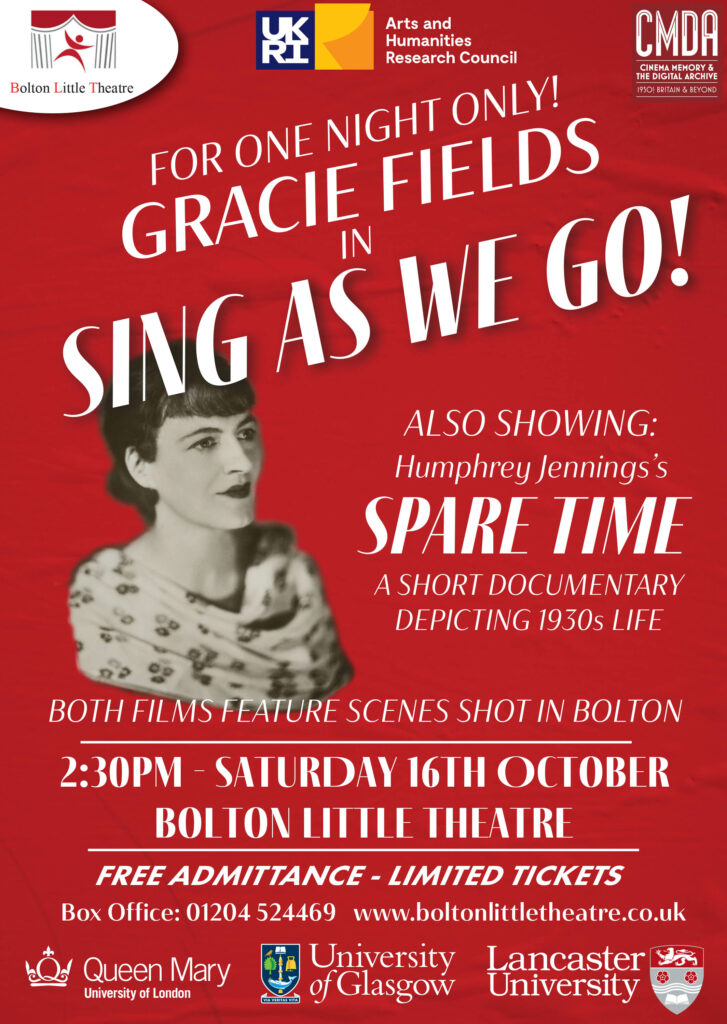Call for Papers: ‘From Cinema Culture to Cinema Memory’
6 – 9 April, 2022
Lancaster University, UK
Keynote Speakers:
Professor Annette Kuhn (Queen Mary University of London)
Professor Daniela Treveri Gennari (Oxford Brookes University)
‘From Cinema Culture to Cinema Memory’ is a three-day conference that invites speakers to discuss a range of themes relating to cinema culture and cinema memory from across the world. The conference will mark the climax of a 3-year AHRC-funded project, ‘Cinema Memory and the Digital Archive: 1930s Britain and Beyond’ (CMDA). The project gathers together a range of material relating to cinema memory in a comprehensive digital archive, a vast amount of which has been made available to view freely online for the first time. Information on this project can be found here: www.lancs.ac.uk/cmda. The relationship between cinema culture and cinema memory is explored in ‘From Cinema Culture to Cinema Memory: a Conceptual and Methodological trajectory’ (Kuhn, upcoming)
Key themes to explored at the conference are:
- What is cinema memory?
- In what ways can memory studies contribute to film studies?
- What methodologies are there for researching cinema memory?
- What is the relationship between audience research and cinema memory?
- What aspects of cinema culture are related to cinema memory?
- What is the place of the film text within cinema memory studies?
- To what extent can creative outputs benefit the study of cinema memory?
- What is the relationship between cinema history and cinema memory?
- What options are there for storing material relating to cinema memory?
- How do archives assist in projects related to cinema memory?
- Gender, race, class, sexuality and cinema memory
- Space, place, and cinema memory
The conference seeks above all to reflect the spirit of CMDA’s remit to revisit and re-assess archival and primary source materials collected as part of the pioneering ESRC funded project, ‘Cinema Culture in 1930s Britain’ (1994-97). That project and its methods, approaches and outputs were formative influences on the creation of what we now consider to be the New Cinema History, with CMDA now drawing influence from the outputs, project and methods that have been carried out under the banner in the intervening twenty-five or so years. As such, ‘From Cinema Culture to Cinema Memory’ welcomes submissions that share in this sense of revisionism and development for the study of cinema culture, cinema memory and a desire to test the boundaries of our methods and approaches.
We invite proposals for twenty-minute papers and anticipate the event being in person, but will be planning for the inclusion of virtual attendance should it be necessary. Whilst not obligatory, we would welcome papers that in some manner reflect upon the materials and findings hosted within our bespoke website/digital archive, which is continually being updated with new items from the archive. You can find out more about the research design of our interview holdings here: https://www.lancaster.ac.uk/fass/projects/cmda/index.php/history/research-design/. A more detailed discussion of the methods and approaches from ‘Cinema Culture in 1930s Britain’ can be found in the appendixes of An Everyday Magic (Kuhn, 2002: 240-54).
We will make available bursaries (to contribute to costs of UK travel, conference fee and accommodation) for up to four post-graduate applicants. Please note in your application if you wish to be considered for a bursary.
Please submit abstracts of no more than 500 words along with a brief (150-word maximum) biography to CMDA@Lancaster.ac.uk by 30th November 2021.
If possible, please also indicate if you would plan to attend the conference in person or via online remote delivery. Your answer at this stage is not definitive and is only to aid our planning.
Keynote speaker biographies:
Annette Kuhn is Professor and Research Fellow in Film Studies at Queen Mary University of London and a Fellow of the British Academy. Publications include Family Secrets: Acts of Memory and Imagination; An Everyday Magic: Cinema and Cultural Memory; Little Madnesses: Winnicott, Transitional Phenomena and Cultural Experience; and, with Guy Westwell, Oxford Dictionary of Film Studies. She was Director of the ESRC project ‘Cinema Culture in 1930s Britain’ and is currently Co-Investigator of ‘Cinema Memory and the Digital Archive (AHRC).
Daniela Treveri Gennari is Professor of Cinema Studies at Oxford Brookes University with a research interest in audiences, memories, film exhibition and programming. Daniela is currently leading the AHRC-funded project European Cinema Audiences: Entangled Histories and Shared Memories. Amongst her recent publications, the jointly authored monograph Italian Cinema Audiences. Histories and Memories of Cinema-going in Post-war Italy (Bloomsbury: London/New York, 2020). Daniela is also a member of the Steering Committee for the AHRC funded project Cinema Memory and the Digital Archive: 1930s Britain and Beyond.
Cited Works:
Kuhn, A. (2002) An Everyday Magic: Cinema and Cultural Memory. London and New York: I. B. Tauris
Kuhn, A. (upcoming). ‘From Cinema Culture to Cinema Memory: a Conceptual and Methodological trajectory’. In: Egan, K., Smith, M., and Terrill, J. Researching Past Screen Audiences, Edinburgh: Edinburgh University Press.
Click here to access this call for papers as a Word document
